When most people think about a chemistry laboratory, they think about hoods and beakers everywhere. In short, they think about the laboratory you might see an organic chemist working in. However, there are all kinds of laboratories in the chemistry world, from practically empty rooms, to those bursting with glassware and smelly compounds everywhere.
In our group, we use broadband rotational spectroscopy, in conjunction with discharge nozzles, to make and probe new molecular species. Our instruments are large metal “chambers” where we create a vacuum. We then pulse our gas into that vacuum chamber, irradiate it with microwaves (similar to those found in your microwave at home), and voilà we record a spectrum of a molecule.

This is the broadband rotational spectrometer at the University of Valladolid. It operates between 2-18 GHz, and we can have up to 3 nozzles running at the same time to introduce our sample.
Once we have recorded the spectrum of our molecule, it looks something like this:

This is the spectrum of the discharge of butanedithiol with acetonitrile.
